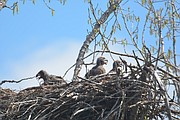Bald eagle triplets: A rare event in nature
After the eaglets hatch, both parents take turns caring for their newest additions. Male eagles typically spend most of their time hunting and defending the nest, while females feed the new chicks by offering them small strips of fish, which they swallow whole.
— The Center for Conservation of Biology
Eagles have always fascinated me ever since I can remember, this spring is no exception. I watched the pair of bald eagles build this nest two years ago last February and raise their young the last two summers.
So, it is no surprise that I am back this year, as one of the eagle family’s biggest fans, watching the eaglets grow up along the Kootenai River in a towering black cottonwood tree overlooking the water.
I have been fortunate to observe two of these eaglets since they stood up in their huge nest. I first saw the eaglets just a few weeks ago this spring, when they poked their unsteady heads up from their nest, but to my amazement there was another wobbly eaglet that finally raised its head and reveal himself to the outside world as the third eaglet in the family. I was totally elated when I observed this rare event in nature and my camera instinctively clicked away.
Bald eagles build their nests at the very top of tall trees so the eaglets will be safe. Some parents, as these parents (who I named George and Martha after our first president and first lady) come back year after year to the same nest, adding more sticks, twigs, and grass each time.
After hatching, the eaglet will dry off and fluff up to a downy gray. Food will be offered to the eaglet by the parent, who shreds meat off fish or whatever is available. Tiny pieces will be offered again and again as the eaglet struggles to hold his wobbly head still long enough to take the food. In a short time, the eaglet becomes stronger and his eating skills and coordination develop quickly.
An eaglet has a crop — a storage area — below its chin. Food goes into the crop and is then digested as needed. When the crop is “full” you can see it bulging out. This crop is actually part of the esophagus where food is stored and softened. The crop regulates the flow of food through the digestive tract.
The eaglets grow rapidly; they add about a half-pound to a pound of body weight every week until they are about 9-10 weeks old, depending on if the eaglet is a male or female. Females are always larger. At about two weeks, it is possible for them to hold their heads up for feeding.
When an eaglet is three weeks old they are one foot high and their feet and beaks are very nearly adult size. When they are four weeks old the eaglets are covered in a secondary coat of gray down, and at about six weeks the young birds are able to stand and tear their own food.
At about 3-6 weeks, black juvenile feathers will begin to grow in. While downy feathers are excellent insulators, they are useless and must be replaced with juvenile feathers before an eaglet can take its first flight, some 10 to 14 weeks after hatching.
When they are about 6 weeks old the eaglets are nearly as large as their parents. The appetites of the eaglets are at its greatest at about 8 weeks. The parents will hunt almost continuously to feed them.
Meanwhile at the nest the eaglets are beginning to stretch their wings in response to gusts of wind, and they may even hover for short periods. The eaglets grow stronger and at about 9-10 weeks they begin branching, this is a precursor to fledging. The eaglets around 10-14 weeks will fledge, or fly away from the nest.
Once the eaglets fledge they may remain around the nest for four or five weeks, taking short flights while their primary feathers grow and strengthen. Their parents will still provide all of their food. The juvenile fledglings, with the exception of their color, look similar to their parents, but are nothing like them in behavior. The juveniles now have to learn to hunt, and they only have what’s left of summer to learn. After that, they’re on their own. The first winter is the most dangerous and difficult part of an eagle’s life.
Enjoy spring and the wildlife of Boundary County!



